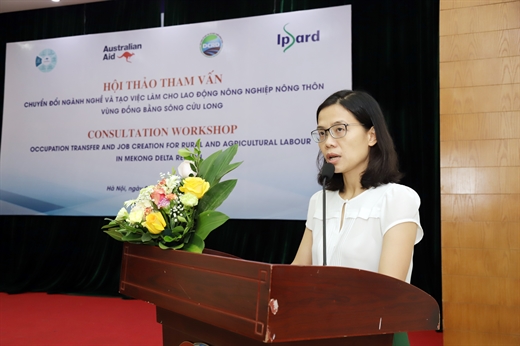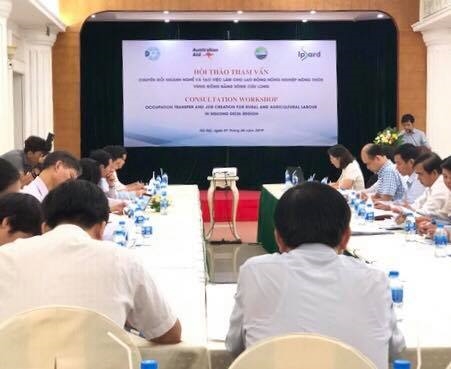Australia supports Economic Reform in Vietnam (Aus4Reform)
- en
- News and Media
- Aus4Reform News
- Rural agricultural labor in the Mekong Delta lack both quality and quantity
2/8/2019
Rural agricultural labor in the Mekong Delta lack both quality and quantity
The Mekong Delta covers an area of 12% of the country, 19% of the contry’s population, rich in potentials for agricultural development, food industry, processing and tourism. However, the level of labor is low, the skills are lacking, and the number of workers with trained jobs is only 12.1% compared to the national average of 21.4%.
Rural agricultural labor in the Mekong Delta lack both quality and quantity
The Mekong Delta covers an area of 12% of the country, 19% of the contry’s population, rich in potentials for agricultural development, food industry, processing and tourism. However, the level of labor is low, the skills are lacking, and the number of workers with trained jobs is only 12.1% compared to the national average of 21.4%.
In the morning of August 1, 2019 in Hanoi, under the framework of The Australia supports Vietnam’s economic reform (Aus4Reform) Program, the Institute of Policy and Strategy for Agriculture and Rural Development (IPSARD) in collaboration with the Department of Cooperatives and Rural Development - Ministry of Agriculture and Rural Development organizes a Consultation Workshop on " Occupation transfer and job creation for rural and agricultural labour in Mekong Delta region".
|
|
|
| Overview of the workshop |
At the workshop, the overall picture of the current situation of labor and employment in the rural agricultural sector in the Mekong Delta was given, along with the barriers in training, occupation transfer and job creation for farm workers in the context of economic development and agricultural restructuring to adapt to climate change in the region.
Current situation of rural agricultural labor in the Mekong Delta
Speaking at the seminar, Ms. Tran Thi Thanh Nhan - Deputy Head of the Department of Market Research and Commodity Development (Ipsard) - said the labor force in this area is aging, the rate of labor in the age under 35 decreased from 45.5% in 2012 to 38.9% in 2017, workers aged 50 and over increased from 20.7% to 26.8%. In agriculture, forestry and fisheries, labors under 35 years old decreased 37.4% to 26.2% and labors aged 50 and over increased 24.1% to 34.1%.
The majority of workers in the agriculture, forestry and fishery sector are untrained, but the level of agricultural labor is increasingly improved when the rate of untrained workers decreases from 97.1% in 2011 to 90.8% in 2017. Labor productivity in services and construction industry is much higher than that in agriculture, forestry and fishery. Labor tends to shift from agriculture, forestry and fisheries to industry, construction and services.
Within the agriculture, forestry and fishery sector, labor shifted from agriculture to fisheries. Unofficial labor in the Mekong Delta region accounts for the highest percentage of the country, but tends to decrease. The average income of workers in the Mekong Delta increased gradually, however, the labor income in agriculture, forestry and fishery was the lowest, 1.6 times lower than that in industry - construction and 1.1 times higher than that in the service. However, this gap is narrowing.
Agriculture, forestry and fishery workers are mainly elderly, poorly skilled , lack of labor situations come out when entering the harvest. Non-agricultural labor in the province do not have many job opportunities in the province, however, the situation of labor recruitment is difficult, low wages, the job for agro-forestry and seafood processing enterprises is not stable ... Therefore the young labor force has migrated to industrial parks in Binh Duong (53%), Ho Chi Minh City (19%), where better working conditions, higher wages, and more stable jobs.
Although the Mekong Delta is the region with the largest training support nationwide, the vocational training effectiveness is the lowest, with 78.3% of trained labors having jobs (the national average is 81.3%).
The reason is that the agricultural and non-agricultural training programs are impractical, mainly focusing on teaching theory, not yet practicing, so they do not meet the requirements of enterprises and markets (100% of businesses interviewed cannot use trained workers).
And a problem that is also worth paying attention to in rural agricultural labor in the Mekong Delta is the inequality between male and female workers. Male workers are more dominant than female workers in all aspects on labor force participation (85% of male workers, 17.7% higher than female workers), technical and professional training, work potential and even on income. The distance of average income of male and female workers in 2010 is 1.3 million VND / person / month, increasing to 1.43 million VND / person / month.
Solutions for vocational training and job creation for agricultural workers to be needed
According to Ms Nhan, the necessary and urgent task is to improve the skill level of workers through vocational training. Prioritize the training of industries suitable to the field of converting manufacturing, remove or raise the limit of the number of studying turn to suit the actual situation and develop effective vocational education establishments. Promote links in training associated with recruitment. The coordination between vocational institutions and businesses must be really tight, trained workers need to be utilized.
 |
| Ms. Tran Thi Thanh Nhan - Deputy Head of the Department of Market Research and Commodity Development (Ipsard) speaks at the seminar |
Having the same opinion, Mr. Truong Kien Tho, Deputy Director of An Giang Department of Agriculture and Rural Development said, currently, An Giang with a population of nearly 2.2 million people, of which the population living in rural areas accounts for 69.25%, The number of labors in agriculture accounted for 53.66%, industry 14.29%, services 32.05%. Thanks to good implementation of agricultural vocational training for rural workers, An Giang has diversified agricultural production, gradually reduced rice cultivation, increased crops, developed large-scale breeding and services for agricultural production.
In summary, in order to meet the requirements of agricultural restructuring proposed by the Government, it is necessary to develop a scheme to change occupations and create jobs for rural agricultural workers to ensure livelihoods and people's lives, and stable and sustainable development, focusing on training for highly skilled rural workers, actively implementing the One Community One Product (OCOP) program. Every individual is good, the team is good. Since then, it aims to develop the Mekong Delta in a comprehensive way.


